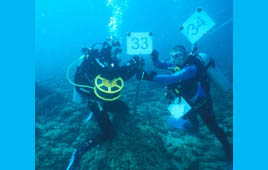I and some U.S. Navy SEALS were cruising in shallow water searching for antiquities, when out of the gloom appeared, fuzzy at first, and then with startling clarity, a fluted Roman column lying on its side. The effect was stunning.
We were diving in Caesarea, the location of one of the finest Mediterranean ports ever built before and during the time of Christ – designed to compete with the contemporaneous port in Alexandria, Egypt.

As we swam on, we encountered large frames made of hydraulic concrete, with remnants of wood still embedded within them. I could barely believe what I was seeing! The Romans had concrete, and used it underwater?
Well, there it was. And imbedded within the concrete remained some of the original wood used within the frames.
I’ve since learned that Roman engineers used a type of hydraulic cement called pozzolana. According to a local maritime historian,
“The Romans found that when they took the volcanic powder found around Mount Vesuvius and mixed it with lime and rubble, the substance hardened in water.” … “This ‘hydraulic concrete’ was imported to Casearea and used to fill wooden frames which were then lowered into the water to lay the foundations for the port.”
At the time of our visit, the diving site was not yet open to tourists, but now it is the site of an underwater museum, through a concerted effort of archeologists and historians.
Which worries me a little. You see, on that dive I didn’t have as much weight on my weight belt as I should have, so I picked up a stone and carried it around with me throughout the dive. Of course as I surfaced from the shallow dive I left the rock on the bottom, somewhere. If that stone had some archeological significance, the information about its placement, relative to the rest of the sunken port, was destroyed by my use of it.
I can only hope that it was a ballast stone from one of the many merchant vessels visiting that port two thousand years ago. That it should serve as my personal ballast stone feels fitting somehow. It was perhaps a connection tying me to ancient mariners.
Or else, it was just conveniently located junk. But, I can imagine, can’t I?
 As of 2006, Herod’s Port has been accessible to tourist divers as an Underwater Museum. Now anyone can dive there, with the benefit of waterproof underwater maps and well marked archeological artifacts.
As of 2006, Herod’s Port has been accessible to tourist divers as an Underwater Museum. Now anyone can dive there, with the benefit of waterproof underwater maps and well marked archeological artifacts.
Caesarea is not your usual diving location, but it is important enough, historically, to make it into my top three.
